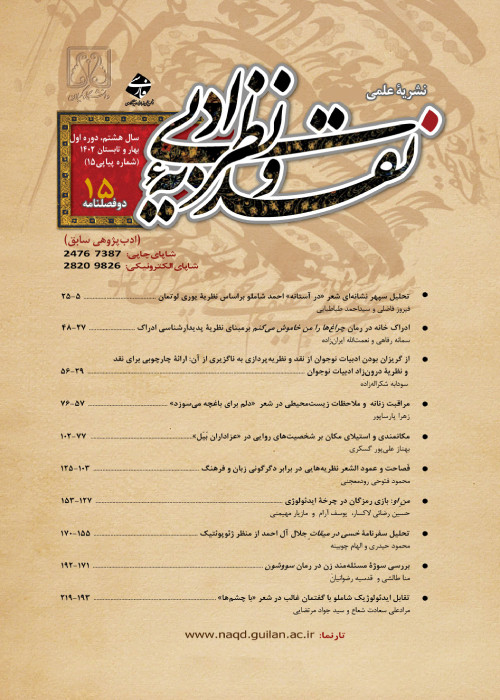A Study of the Absolute Metaphors the ‘Way’ and the ‘King’ in Tazkirat al-Awliya and Asrar al-Tawhid, based on the Views of Hans Blumenberg
Author(s):
Article Type:
Research/Original Article (دارای رتبه معتبر)
Abstract:
As the most important mystical concept, Truth is the culmination of mankind’s contemplation of his relation to existence and its Creator (Haq). Since these general concepts cannot be articulated through a theoretical framework, they enter the realm of metaphors, which are images resulting from the relationship between the components of this whole. Employing Blumenberg’s metaphorology, the present article studies the mechanism whereby an idea is transformed into a metaphor, and examines its application in illuminating the two important motifs of mysticism, i.e., Truth and the Path (ṭaríqat). In Hans Blumenberg’s thought, an absolute metaphor starts with a fundamental primordial principle. Concepts move from the domain of objectivity to the metaphysical domain, and through repetition and making connections between the components of the concepts, an absolute metaphor is formed and becomes axiomatic. Emphasizing the significance of absolute metaphors in explicating mystical concepts, the article further investigates the concept of ‘progress’ (sayr) and its components in mystical allegories, studies the mutations of a concept by considering the history of metaphors, and discusses concepts such as asceticism (ryazat) which, due to repetition, have been fixated in the lexical domain. Extended Abstract 1.IntroductionCoding is the main mechanism of the metaphors of Truth. By analyzing the history of the metaphor of light, Blumenberg identifies a schema whose components form the metaphor of light. In the present study, we have focused on the characteristics of ‘sayr’ (progress) and concepts that can be collected within the framework of ‘tariqat’ (way) and Truth, and have concluded that the metaphors the ‘way’ and the ‘king’ in mysticism, which revolve around the concept of Truth, are based on the history and components of such a schema. 2.Theoretical FrameworkWhen using a metaphor to express a concept, we deal with all aspects of a specific phenomenon rather than just its metaphysical aspects. While in mysticism, the metaphysical aspect is of importance, Blumenberg stresses that the concept of Truth in the metaphor of light is associated with the whole nature of light rather than a part of it. Therefore, in metaphors such as ‘light’ (Truth), the ‘way’ (mystical journey) and the ‘king’ (Truth), an ontological explanation of this concept can be offered only through an objective, natural experience. 3.MethodologyTo study the metaphors the ‘way’ and the ‘king’ we drew upon Blumenberg’s concept of Truth and the use of metaphors connected with it, such as ‘light’. In the present study, these concepts have been compared with mystical concepts. 4.Discussion and AnalysisIn discussing the components of the allegory of the ‘cave’, Blumenberg points to components that form the metaphor ‘light’, such as the darkness inside the cave and the fire outside. Based on the concept of semantic cluster, we discuss how a number of concepts can be expressed through a single metaphor, and give two important metaphors in mystical texts as examples. Blumenberg believes that the concepts in a single semantic cluster are collected through a single main metaphor in a single structure, and referring to any single component can evoke all associated concepts. Drawing upon this idea, we examine the components of the semantic cluster of the metaphors the ‘way’ and the ‘king’, each of which refer to a specific topic in mysticism. 5.ConclusionThe presence of a semantic context or cluster is the main difference between absolute metaphors and decorative metaphors. Decorative metaphors are aimed at creating a piece of beautiful writing, while absolute metaphors are used to express concepts and develop specific terms. Absolute metaphors are important in that they help develop concepts through which ideas are expressed. Select BibliographyAttar, M. A. 1388 [2009]. Mantiq al-Tayr. M. Shafiee Kadkani (ed.). Tehran: Sokhan.Attar, M. A.1389 [2010]. Tazkirat al-Awliya. M. Shafiee Kadkani (ed.). Tehran: Sokhan.Blumenberg, H. 1957. “Light as a Metaphor for Truth.” J. Anderson (trans.). Studium Generale 10/7: 30-44Blumenberg, H. 2010. Paradigms for a Metaphorology. R. I. Savage (trans.). Ithaca, N.Y: Signale.Hafiz. 1387 [2008]. Divan-e Hafez-e Shirazi. M. Qazvini and Q. Ghani (eds.). Tehran: Yasavoli.Mohammad bin Monavvar. 1390 [2011]. Asrar al-Towhid fi Maqamat al-Sheikh abi Saeed. M. Shafiee Kadkani (ed.). Tehran: Agah.Mowlawi, J. 1373 [1994]. Masnavi Ma’navi. R. Nicholson (ed.). Tehran: Amir Kabir.Sanaee, M. 1329 [1950]. Hadiq al-Haqiqat va Shari’a al-Tariqa. M. Modarres Razavi (ed.). Tehran: Sepehr.Sontag, S. 1977. Illness as Metaphor. New York: Farrar, Straus and Giroux.Wetz, F. J. 1393 [2014]. Daramadi bar Andisheh-ye Hans Blumenberg. A. Nasri and F. Farnoudfar (trans.). Tehran: Cheshmeh.
Keywords:
Language:
Persian
Published:
Literary Theory and Criticism, Volume:7 Issue: 1, 2022
Pages:
103 to 136
magiran.com/p2523248
دانلود و مطالعه متن این مقاله با یکی از روشهای زیر امکان پذیر است:
اشتراک شخصی
با عضویت و پرداخت آنلاین حق اشتراک یکساله به مبلغ 1,390,000ريال میتوانید 70 عنوان مطلب دانلود کنید!
اشتراک سازمانی
به کتابخانه دانشگاه یا محل کار خود پیشنهاد کنید تا اشتراک سازمانی این پایگاه را برای دسترسی نامحدود همه کاربران به متن مطالب تهیه نمایند!
توجه!
- حق عضویت دریافتی صرف حمایت از نشریات عضو و نگهداری، تکمیل و توسعه مگیران میشود.
- پرداخت حق اشتراک و دانلود مقالات اجازه بازنشر آن در سایر رسانههای چاپی و دیجیتال را به کاربر نمیدهد.
In order to view content subscription is required
Personal subscription
Subscribe magiran.com for 70 € euros via PayPal and download 70 articles during a year.
Organization subscription
Please contact us to subscribe your university or library for unlimited access!



